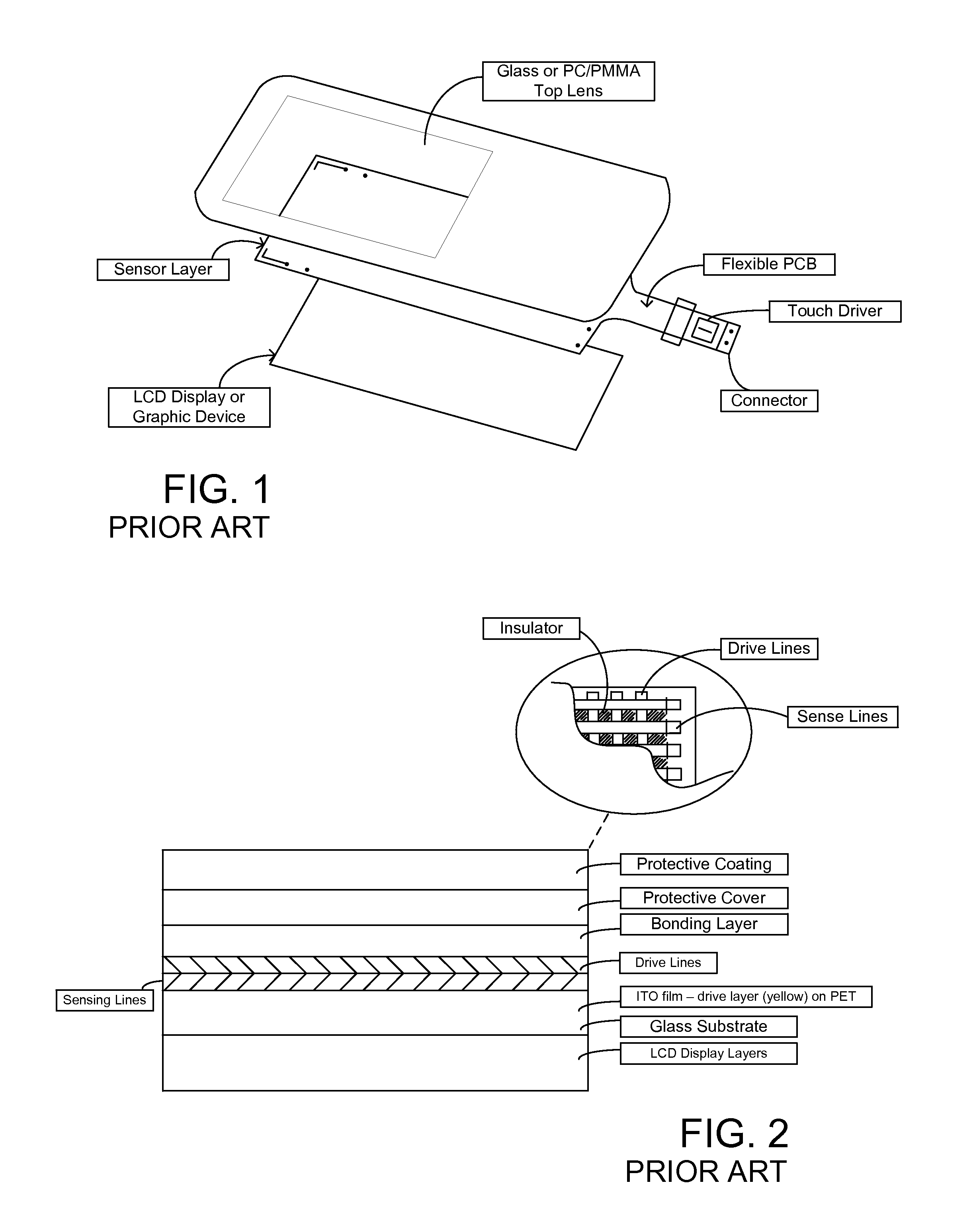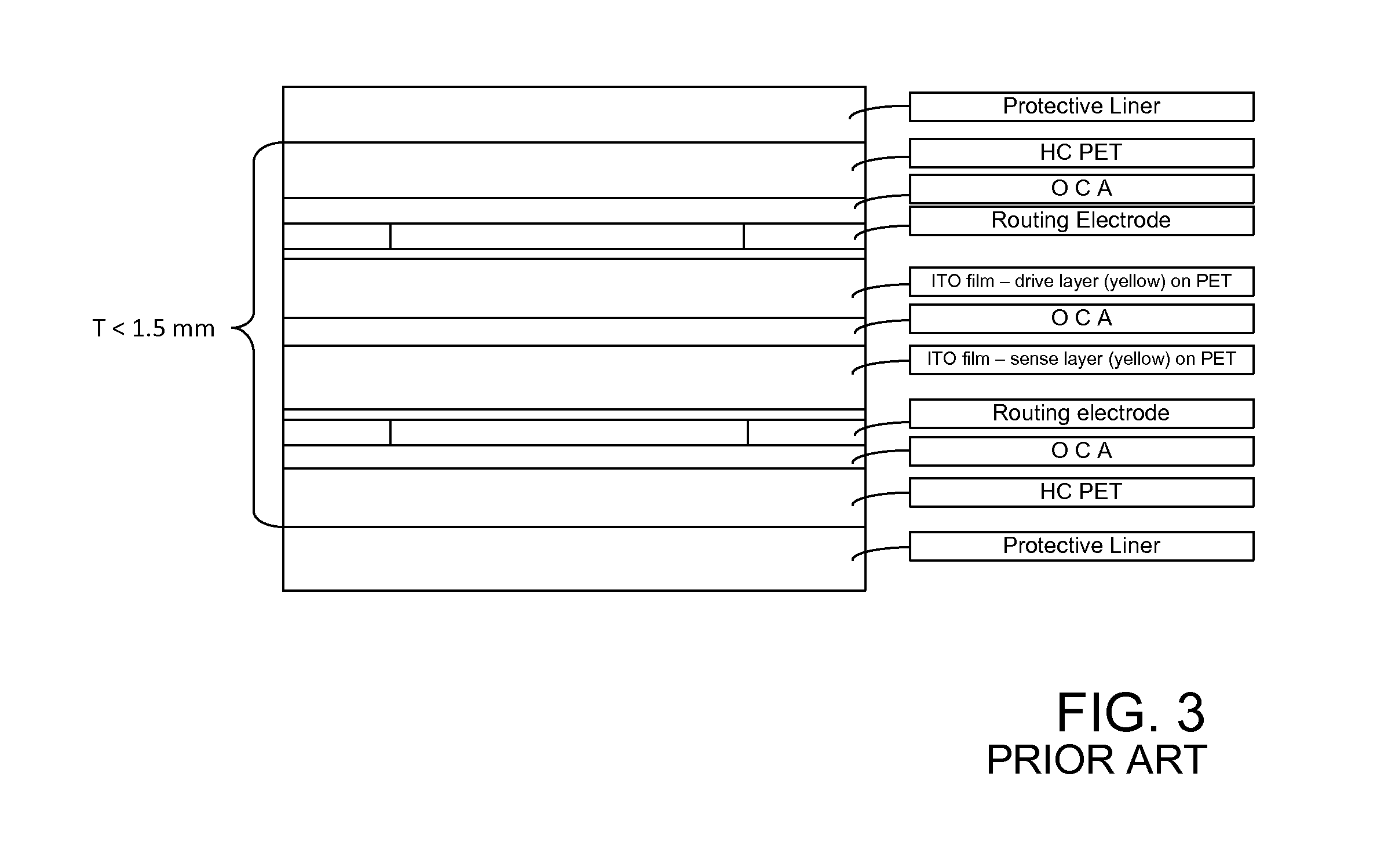Methods and apparatus for the fabrication of pattern arrays in making touch sensor panels
a technology of pattern arrays and touch sensors, applied in the direction of lamination ancillary operations, instruments, computing, etc., can solve the problems of film shrinkage, though greatly reduced, still observed, and increase the conductivity of ito, so as to reduce the error associated with coating alignment, improve the resulting registration of the conductive array, and improve the effect of registration and alignmen
- Summary
- Abstract
- Description
- Claims
- Application Information
AI Technical Summary
Benefits of technology
Problems solved by technology
Method used
Image
Examples
example 1
[0055]A touch panel 100 made from silver nanowire conductors having a layer construction as illustrated in FIG. 9 may be fabricated by the method of the present disclosure. The panel construction is similar to the construction illustrated in FIG. 3, except the conductive coatings are instead conductive coatings comprising silver nanowires (in contrast to ITO). In this example, the silver nanowires are solution-coated with PMMA (Polymethylmethacrylate (Acrylic)) binder. Typical binder thickness is approximately 6 μm. The substrate is PET (Polyethylene Terephthalate), having typical substrate thickness of approximately 100 μm. The conductive layers may be separated by an insulator, for example, an insulting layer such as a substrate or an adhesive layer in order for the electrically conductive array to function as a touch sensor.
[0056]The method of fabricating the laminate construction, or touch sensor panel, according to the present disclosure is distinct over the prior art processes...
example 2
[0068]A touch panel 200 made from silver nanowires conductors having a layer construction as illustrated in further detail in FIG. 11 may be fabricated as follows: the silver nanowires are spin-coated with PMMA binder sequentially onto both sides of a 400 μm PC substrate. The PMMA binder has a thickness of approximately 6 μm. A 2.15 μm laser can be used for patterning the electrical arrays on both conductive coatings, on both sides of the substrate. For a double-side coated substrate, no lamination is necessary before laser patterning the conductive layers as once each layer is coated onto a respective, opposing side of a substrate, the layers are in a fixed orientation with respect to one another. FIG. 12 illustrates these simplified processing steps. Processing steps 212 to 242 are illustrated in FIG. 12 and include, for example, coating the nanowire silver film on to both sides of a PC substrate 212; laser imaging on both the drive and sense layers 216, printing a silver ink on t...
example 3
[0071]A silver nanowire coated PET film is normally received with a 50 μm thick PE (Polyethylene) release liner on top to protect the coating surface. By providing better intimate contact between the release liner and the film and by placing the film under a scanning 1.04 μm laser without removing the liner, terminating score lines were formed on the conducting layer, similar to lines obtained when processing with the protective liner removed. Upon removing the liner after imaging, no smoke, debris or other damages were observed on the film surface after visual inspection under a microscope at 90× power. Unlike the conventional patterning methods with generally include litho / etch wet processes or laser ablating / evaporation processes where the liner must be removed, the current laser patterning process can be conducted without the removal of the protective liner. No post cleaning step nor application of new protective liner is required. In Examples 1 and 2 wherein a 2.15 μm laser may...
PUM
| Property | Measurement | Unit |
|---|---|---|
| wavelength | aaaaa | aaaaa |
| size | aaaaa | aaaaa |
| width | aaaaa | aaaaa |
Abstract
Description
Claims
Application Information
 Login to View More
Login to View More - R&D
- Intellectual Property
- Life Sciences
- Materials
- Tech Scout
- Unparalleled Data Quality
- Higher Quality Content
- 60% Fewer Hallucinations
Browse by: Latest US Patents, China's latest patents, Technical Efficacy Thesaurus, Application Domain, Technology Topic, Popular Technical Reports.
© 2025 PatSnap. All rights reserved.Legal|Privacy policy|Modern Slavery Act Transparency Statement|Sitemap|About US| Contact US: help@patsnap.com



